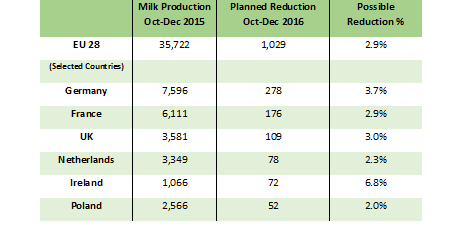EU Voluntary Milk Reduction Scheme Effectively Full After First Period
The EU’s Voluntary Milk Reduction Scheme is effectively full after the first period. A total of 52,101 dairy farmers from across the EU submitted an application form under the first round of the EU’s voluntary milk reduction scheme covering the months of October, November and December 2016. Applications were submitted by dairy farmers across 27 EU Member States, with the exception of Greece. The budget for the scheme is now virtually exhausted with over €148 million, out of a total budget of €150 million allocated to the first round.
In Ireland, 4,447 dairy farmers submitted an application form, corresponding to a reduction of 74,225 tonnes. In 2015, Irish milk supply for October to December was just over 1 billion litres. Therefore, a planned reduction of 74,225 tonnes will equate to a 6.8% decline in milk supply over the 3 month period. The value of 74,225 tonnes at 14c/kg is worth €10.4 million to dairy farmers, which is an average payment of just over €2,300 per farmer across the 4,447 applications. The average planned reduction per applicant in Ireland is a little under 16,500 litres. Ultimately, this is a voluntary scheme, without penalties, should a farmer decide against reducing his supply for cash flow reasons. However, the legislation does contain a sliding scale, whereby aid will be reduced if the actual reduction by a farmer does not correspond to his planned reduction in the application form. Unused monies under the scheme will return to the EU budget.
“Planned Reduction” is now the “Authorised Reduction”
An allocation coefficient will not be established for the first round (Oct-Dec 2016) as the scheme was under subscribed by a hair’s breath. This means that the “planned reduction” submitted by a dairy farmer in his application form, is now known as the “authorised reduction”, assuming the application submitted met with other criteria under the legislation, such as, applicants can only reduce a maximum of 50% of his milk supply within the reference period.
What happens next?
Once the reduction period ends in December, applicants will have 45 days (until mid-February 2017) to submit an application for payment. The application for payment will be on the basis of “actual reduction”. Payment will be provided to farmers within 90 days of the end of the reduction period (end of March 2017). The full amount of aid will be paid on the actual reduction, if it is not more than 20% below the authorised reduction. Aid will be paid on 80% of the actual reduction, if this actual reduction is between 50%-80% of the authorised reduction. Aid will be paid on 50% of the actual reduction, if this actual reduction is between 20%-50% of the authorised reduction. No aid will be paid if the gap between the proposed and authorised reduction is more than 80%.
Summary of Milk Reduction Scheme
Outlined in the table below (expressed in million litres) is the “planned reduction” for the EU and selected countries. Ireland ranked 5th in terms of planned volume reduction and 3rd in terms of number of applicants.
Table: Planned Reduction (million litres)

Source: AHDB, European Commission, Eurostat
Will there be a second round?
A second round is now open covering the period November, December and January, with a dramatically reduced budget of €1.6 million for 11,407 tonnes. Anyone who submitted an application under the first round cannot apply for the second round. Furthermore, due to the small volume remaining under the second round, an allocation coefficient will be established in all likelihood making the second round redundant in many respects. The deadline to apply for the second round is 10th October.
By Eamonn Farrell
Agri Food Policy Executive